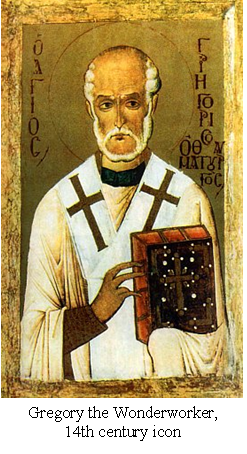Proclaiming the Gospel with Miraculous Gifts in the Postbiblical Early Church
What seems clear is that the supernatural has accompanied gospel preaching in all periods of Christian history (see the sources cited in note 2 for surveys of the evidence). Yes, there have been ups and downs—but there never seems to have been a total absence of the charismata. To illustrate this, I have chosen to discuss four selected examples of Spirit-empowered ministry—two from both East and West—during the first six centuries of the Christian era.
Gregory Thaumaturgus (“Wonder-worker”) (ca. 213-ca. 270)
 Gregory was born about 213 at Neocaesarea (in Asia Minor, presently Turkey), the son of wealthy, noble parents. His father was devoted to the worship of pagan deities. When Gregory was fourteen years old, his father died and Gregory became a student of the famous Alexandrian theologian, Origen, under whose tutelage he became a devout Christian.
Gregory was born about 213 at Neocaesarea (in Asia Minor, presently Turkey), the son of wealthy, noble parents. His father was devoted to the worship of pagan deities. When Gregory was fourteen years old, his father died and Gregory became a student of the famous Alexandrian theologian, Origen, under whose tutelage he became a devout Christian.
Origen probed his student with questions and taught him to think critically, investigating philosophy, physics, and ethics. Gregory later praised Origen as one who mediated him through divine charisma, speaking as those who prophesy and interpret mystical and divine words.5
Following his schooling (ca. 230), Gregory returned to his native Neocaesarea, where, according to his follower, Gregory of Nyssa, there were but seventeen Christians. When Gregory the Wonderworker died forty years later, there were only seventeen in Neocaesarea who were not Christians!6
How was this mass conversion accomplished? At least four of the Church Fathers speak to this question. One of Gregory’s spiritual descendants was Basil of Cappadocia. In Basil’s famous work On the Holy Spirit, he argues that Gregory should be placed among the Apostles and Prophets as a person who walked by the same Spirit as they.7 Specifically, Basil reports that by the “fellow-working of the Spirit” Gregory had tremendous power over demons, and was so spiritually gifted that his evangelism was dramatically successful. Basil lists a few of the miracles credited to Gregory’s ministry (including prophecy and the turning of the course of rivers). He concludes:
By the superabundance of gifts, wrought in him by the Spirit in all power and in signs and in marvels, he was styled a second Moses by the very enemies of the Church. Thus in all that he through grace accomplished, alike by word and deed, a light seemed ever to be shining, token of the heavenly power from the unseen which followed him.
Gregory of Nyssa, another of Gregory the Wonderworker’s followers, wrote an essay on his predecessor which seeks to explain the evangelistic success of the Wonderworker. Throughout it is assumed that miracles and other supernatural phenomena resulted in mass conversions.8
In his history of the Early Church, the fourth century historian, Socrates, reports that pagans were no less attracted to the Christian faith by his marvelous acts, than by his words. He reports many miracles, healing of the sick, and the casting out of devils even by means of his letters.9
Category: Church History, Summer 2008


